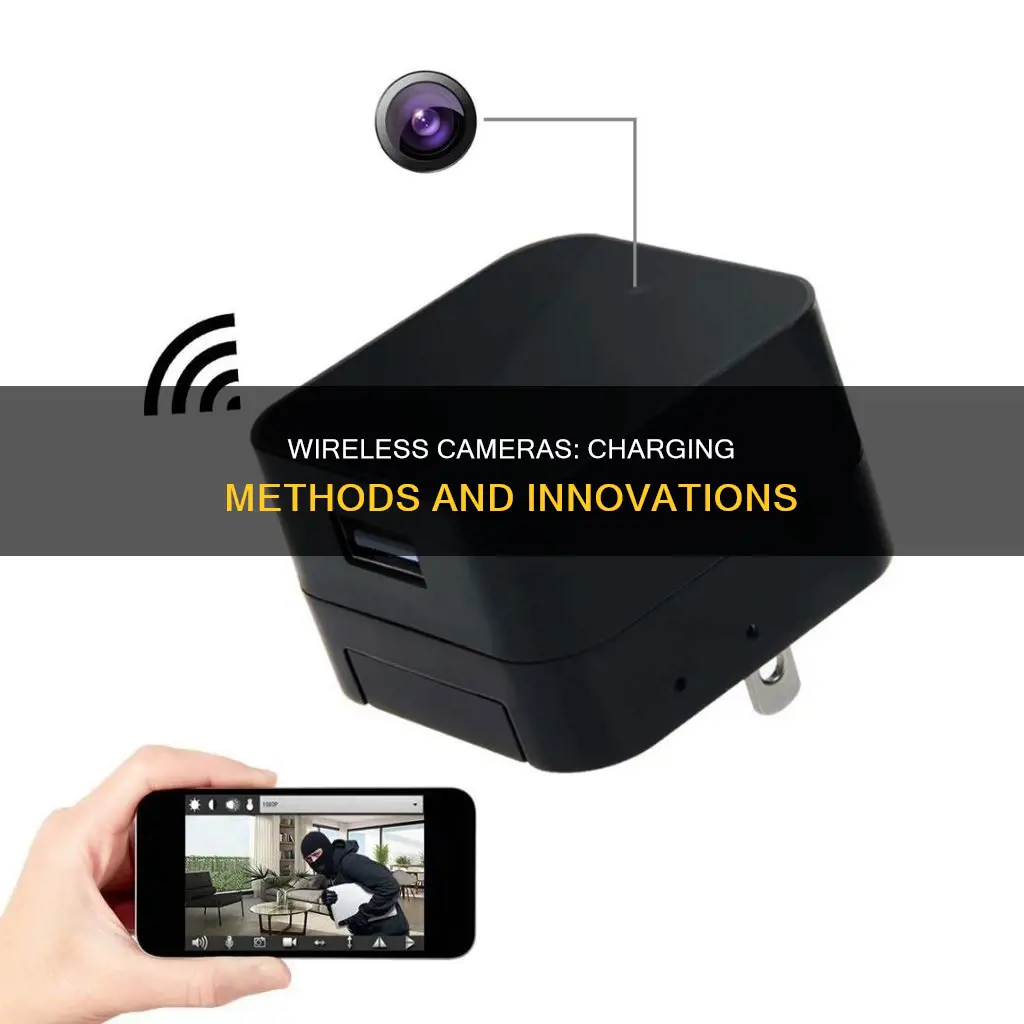
Wireless security cameras are a convenient alternative to wired cameras, offering ease of use and features like cloud storage and push notifications. However, they rely on various power sources to function, and understanding how they charge is essential for ensuring uninterrupted surveillance. These cameras can be broadly categorised into three types based on their power sources: those that need to be plugged into electrical outlets, those powered by batteries, and those that harness solar energy.
Pluggable wireless cameras require a cable for power and must be connected to an electrical outlet, making them dependent on a stable power supply. On the other hand, battery-powered wireless cameras offer true wire-free flexibility, transmitting data wirelessly without the need for additional cables. Solar-powered security cameras, while less common, utilise solar panels to collect solar energy, storing it in rechargeable batteries.
While wireless cameras offer advantages in terms of installation and placement, they require careful consideration of power management. Understanding these power sources and their respective charging methods is crucial for maintaining the functionality and reliability of wireless security cameras.
| Characteristics | Values |
|---|---|
| Wireless security camera charging methods | Portable solar panel, high-capacity power bank, power generator, alternative battery |
| Wireless security camera power sources | Rechargeable batteries, electrical outlets, solar power |
| Wireless security camera battery life | 1-6 months, depending on usage, settings, temperature, etc. |
| Wireless security camera charging time | 2-10 hours, depending on frequency of charging |
What You'll Learn

Wireless security cameras with rechargeable batteries
Wireless security cameras are a convenient alternative to wired cameras, as they are easy to install and can be placed almost anywhere. However, they are powered by batteries, which can be annoying as they need to be periodically replaced or recharged.
Some models, like the ZUMIMALL Security Cameras, offer a built-in rechargeable battery that can last up to 3-6 months on standby mode. The battery life will depend on the number of times the camera is activated and the settings. These cameras also feature motion detection and night vision, allowing them to capture clear footage even in low-light conditions.
Another option is the Geeni Freebird 1080p Outdoor WiFi Surveillance Camera, which is compatible with Alexa and offers motion detection and night vision. This camera is also easy to install and can be controlled via a mobile app.
When choosing a wireless security camera with rechargeable batteries, it is important to consider factors such as battery life, video quality, motion detection capabilities, night vision, and ease of installation. Additionally, some cameras offer cloud storage or local storage options, allowing you to save and access footage at any time.
Overall, wireless security cameras with rechargeable batteries offer a convenient and flexible solution for home security, providing peace of mind without the hassle of frequent battery replacements.
Monthly Fees for Cellular Cameras: What's the Deal?
You may want to see also

Wire-free cameras
One way is to use a portable solar panel. This method uses renewable, clean energy, but requires the installation of a charge controller to adjust the voltage output from the solar panel to the battery input. On sunny days, solar panels can generate more energy than a battery can handle, so a charge controller is necessary to prevent damage to the battery.
Another option is to use a high-capacity power bank, which can be connected to the camera via a micro USB cable. Power banks come in various shapes and sizes, and it is recommended to purchase one that can fully charge the camera.
A third method is to use a power generator, which can be beneficial for temporary situations or when there is no access to a power source. However, it is important to use a portable inverter generator as they are quieter, lighter, more efficient, and produce high-quality electricity.
Finally, wire-free camera batteries can be replaced with rechargeable or non-rechargeable batteries, depending on the camera model. It is important to consider the battery type, voltage, and size when replacing batteries to ensure compatibility and avoid potential damage to the camera.
The battery life of wire-free cameras varies depending on factors such as motion detection, night vision, Wi-Fi connectivity, placement, temperature, and streaming usage. On average, these cameras can last between two and six months under regular use.
Charging Your ADT Doorbell Camera: Quick and Easy Steps
You may want to see also

Solar-powered wireless cameras
The solar panels connected to the wireless cameras typically feature photovoltaic cells, which are designed to absorb light energy and convert it into electrical energy. This electricity is then used to charge the camera's built-in rechargeable battery, ensuring it remains operational even in the absence of direct sunlight.
One notable advantage of solar-powered wireless cameras is their flexibility in placement. Unlike traditional wired cameras, these cameras are not restricted by the length of a cable, allowing them to be positioned virtually anywhere, both indoors and outdoors. This makes them ideal for monitoring areas that may be challenging to reach or where running cables would be impractical.
Additionally, solar-powered wireless cameras often offer smart features such as motion detection, night vision, and instant alerts. With motion sensors, the cameras can detect human movements and trigger alerts, ensuring you're always aware of any suspicious activities. The night vision capability allows for clear surveillance even in low-light conditions, providing valuable visual details to identify people and objects.
It is worth noting that the effectiveness of solar-powered wireless cameras can be influenced by factors such as weather conditions, sun exposure, and the efficiency of the solar panels. However, advancements in solar technology have made these cameras increasingly reliable, making them a popular choice for homeowners, renters, and businesses alike.
Overall, solar-powered wireless cameras offer a convenient, eco-friendly, and cost-efficient solution for security and surveillance needs, providing peace of mind and deterring crime simply by being present.
Charging the Wyze Camera: Quick and Easy Steps
You may want to see also

Power generators for wireless cameras
Wireless cameras are a convenient way to improve security, but they do require a power source to function. There are several options for powering wireless cameras, and each has its advantages and disadvantages.
Solar Power
Solar-powered security cameras are becoming an increasingly popular option for wireless camera setups. Solar panels are affordable, durable, and require minimal maintenance. They provide a free and unlimited energy source, as long as they are positioned correctly. Solar-powered cameras can be installed without hard wiring, making them a convenient DIY solution.
Solar-powered cameras can also operate at night or during cloudy periods by storing energy in rechargeable batteries. However, they may struggle in areas with frequent cloud cover or rainy days, and the panels may need to be supplemented by another power source.
Battery Power
Battery-powered wireless cameras are another popular option. Batteries provide independence from external elements and power outages, and they are easy to install and affordable. They can be placed almost anywhere since they don't need to be near an electrical outlet.
However, batteries will need to be replaced or recharged periodically, and this can be inconvenient, especially if the camera is in a hard-to-reach area.
Generators
Generators are another option for powering wireless cameras. While they may not be as convenient as solar or battery power, they can provide a reliable source of energy, especially in areas with frequent cloud cover or limited sunlight.
Portable generators can be used to power security cameras and other devices, and they can be recharged through various methods, including power outlets, carports, and solar panels.
Plug-in Power
Some wireless cameras are plug-in, meaning they are powered through an electrical outlet. While these cameras may not be truly "wire-free", they eliminate the need for frequent battery replacements or recharging.
Hybrid Solutions
For the most reliable performance, a combination of power sources may be the best solution. For example, solar-powered cameras can be supplemented by backup batteries or generators to ensure continuous operation, even during periods of limited sunlight.
Factors to Consider
When choosing a power source for wireless cameras, it's important to consider factors such as camera location, ease of installation, maintenance requirements, and cost. Additionally, the power requirements of the camera itself, including features like night vision or continuous recording, will impact the choice of power source.
Charging the Elinksmart Camera: Always-on or Timed Sessions?
You may want to see also

Portable power banks for wireless cameras
Wireless cameras are wire-free and run on batteries. However, they are not completely free of wires, as they need to be plugged into electrical outlets to be charged. The frequency of charging wireless cameras depends on factors such as camera usage, battery capacity, settings, temperature, firmware, and others.
Portable power banks are a convenient solution for charging wireless cameras on the go. Here are some key points to consider when choosing a power bank for your wireless camera:
- Capacity: Look for power banks with a capacity of at least 2,000 mAh and up to 10,000 mAh. This will ensure that you have enough power to charge your camera multiple times.
- Weight and Size: Aim for power banks that are lightweight and compact, making them easy to carry in your pocket or bag.
- Charging Speed: Choose power banks with fast charging capabilities, such as those with USB-C PD (Power Delivery) ports, to ensure efficient charging for your devices.
- Built-in Cables: Consider power banks with built-in cables, such as USB-C and Lightning connectors, to eliminate the need for carrying additional charging cables.
- Warranty: Opt for power banks that offer at least a one-year warranty to ensure you have sufficient time to test and verify the product's functionality.
- Belkin Boost Charge Plus 10K: This power bank offers a good balance between size and capacity. It has a USB-C PD port, built-in USB-C and Lightning cables, and can charge most smartphones up to three times.
- TravelCard Plus: If you prioritize portability, the TravelCard Plus is an ultra-slim option that can fit in your wallet. It has built-in USB-C and Lightning cables and offers a capacity of 3,000 mAh, making it ideal for topping off your devices.
- Scosche GoBat 10K: As a budget-friendly alternative, the Scosche GoBat 10K provides similar power and capacity to the Belkin option but lacks built-in cables. It has a USB-C PD port and a USB-A port for older devices.
- Mophie Powerstation Plus: For maximum power, consider the Mophie Powerstation Plus, which offers slightly more power than the previous options. It has a built-in USB-C PD cable, a USB-C PD port, and a Lightning output cable. However, it is more expensive and lacks the convenience of built-in cables.
- Anker PowerCore Fusion 10000: This power bank doubles as a wall charger, featuring a fold-up input plug, a USB-C PD port, and a USB-A port. It has a capacity of 10,000 mAh but is bulkier and heavier than the other options.
- Zendure SuperMini 20W: The Zendure SuperMini 20W is another good choice, offering a USB-C PD port, a USB-A port, and passthrough charging. It has a capacity of 10,000 mAh and is known for its portability and ease of use.
Simplesafe Camera Costs: Monthly Fees or One-Time Payment?
You may want to see also
Frequently asked questions
This depends on several factors, including camera usage, battery capacity, security camera settings, temperature, firmware, and others. On average, wireless security cameras need to be charged between every 1 and 6 months.
Charging times vary between 2 and 10 hours. Cameras that require more frequent charging will charge faster, while those that last several months between charges will take longer.
There are several ways to charge wireless security cameras, including:
- Using a portable solar panel and a charge controller to adjust the voltage output.
- Using a high-capacity power bank or portable power station with a micro USB cable.
- Using a power generator, such as a portable inverter generator, which is quieter, lighter, and more efficient.
- Replacing the battery with a rechargeable or non-rechargeable alternative, ensuring it is the correct voltage and size.
Wireless security cameras offer several benefits over wired cameras, including ease of installation and operation, advanced features like machine learning, and the ability to view footage anywhere. However, they also have some drawbacks, such as dependence on Wi-Fi signals, high bandwidth requirements, and susceptibility to signal loss or interference outdoors.







